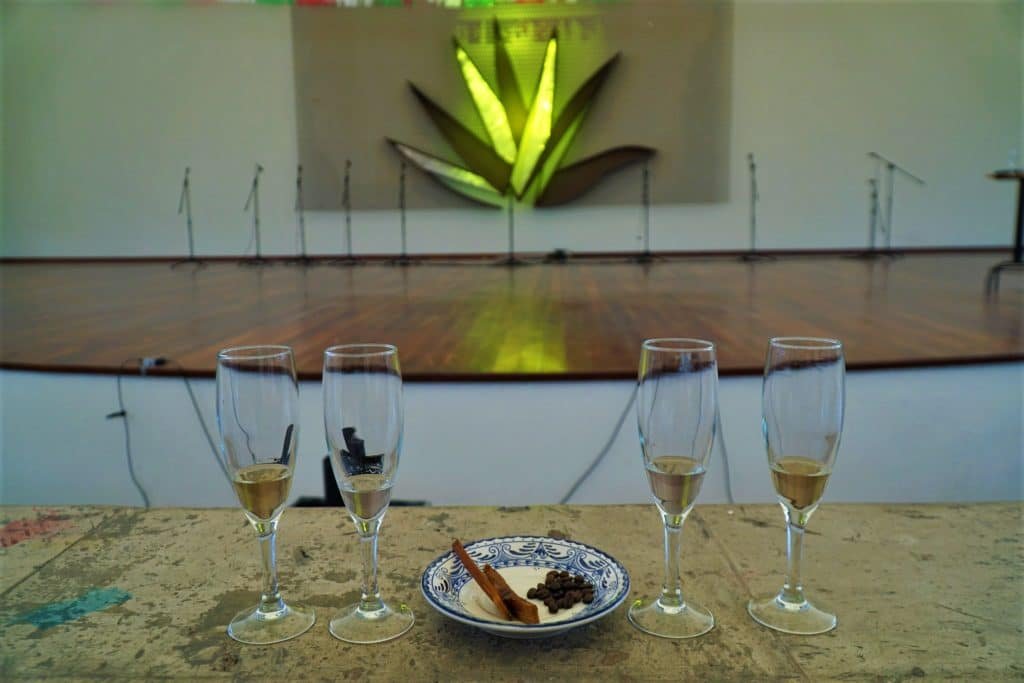After visiting blue agave fields, our tour continued at the Jose Cuervo distillery known as La Rojeña. Choosing to visit Jose Cuervo over any other distilleries in the area was an easy decision. Jose Cuervo is the birthplace of tequila mass production and one of the oldest distilleries in Latin America. Founded by Don José Antonio de Cuervo, it is today run by his descendants. The distillery works like a time machine, transporting you to old, colonial Mexico. It's decorated with numerous statues of crows ("cuervo" is the Spanish word for "crow"), which gives it a strangely poetic feel.

At the entrance, we were greeted by a small, stubborn bulldozer battling a hill of oversized blue agave piñas, shoving them toward the ovens. The guide explained that once piñas are taken from the fields, they are baked for 36 hours at 96 degrees Celsius. The cooked agave is then shredded, and the extracted juice ends up in the giant vats for fermentation, and then distillation follows. Soon, I noticed that people in our group started to lose interest in how tequila is made, and instead were impatiently waiting for the promised tasting at the end of the tour. The guide paid no attention to the wandering gazes and occasional pained sighs; she marched through her presentation like a trooper, bombarding us with facts about distillation, bottling, and storage. She finally finished off by boasting that Jose Cuervo is the best-selling tequila, claiming 35% of the world’s market, but the mood of the group was “show, don’t tell.”

We then sat in a large open-air auditorium to sample four types of tequila: blanco (“white”)/plata (“silver”), reposado (“rested”), anejo (“aged”), and extra anejo (“extra aged”). The main differences were how long they were aged and whether the aging took place in oak or stainless-steel barrels. The guide cautioned that blanco didn’t have a smooth taste, as it was just white spirit aged in a stainless-steel barrel for less than two months. It's primarily used for making cocktails and margaritas, not drinking straight up. She was right—the flavor was too harsh. Julia took a tiny sip and immediately pushed the rest of her sample toward me, but I couldn’t finish my own. On the other side was extra anejo, aged in an oak barrel for a minimum of three years, which had a dark color and a smooth taste with notes of chocolate or coffee. As we learned, the longer the spirit ages in a cask, the more it takes on the flavor of wood, mellowing the harshness of alcohol. It's no surprise that extra anejo is the most expensive tequila.


After the tasting, we had about two hours of free time to walk around—or, in cases of some visitors, stumble around—the town center, just a few blocks from the distillery. This was a sunny Saturday in March, and the central street leading to the plaza was bustling with tourists. The word “tequila” was on every sign and banner. We chuckled as we remembered visiting Springfield, Illinois, and seeing the word “Lincoln” plastered all over the town: the barbershop “Lincoln”, the auto repair shop “Lincoln”, and so on. Here, it was impossible to miss that we were in Tequila.
For lunch, we dropped by a colorfully decorated restaurant named after Mexican hot sauce Cholula and indulged in one of Jalisco's delicacies: tortas ahogadas (“drowned sandwiches”), sandwiches covered in a tomato-based sauce with a hint of chili.

In the afternoon, we returned to the distillery for the rest of the program, which included a dance show and mariachi music. Frankly, I didn’t expect much from this portion of the day. I thought it would be too cheesy and touristy. Surprisingly, it wasn't. Jalisco gave the world tequila and mariachi music, and experiencing these two very Mexican things in their birthplace felt totally authentic. Tequila-based cocktails flowed with no limits, and Mexican and foreign tourists got rowdy, singing and dancing to the mariachi songs.
The best part of the trip was saved for the end: a luxury Jose Cuervo Express train ride back to Guadalajara. At the station, the elegant black train with Jose Cuervo’s logo was awaiting us. As we were settling into our seats, the mariachi band played a farewell tune. Because the luxury part didn't really interest us, when we purchased the tour, we chose the least expensive wagon. In all honesty, our Express wagon with its beautiful wood-paneled walls and comfortable seats had more luxury than we were usually accustomed to. The more expensive wagons, Premium Plus and Diamond, offered even more comfort and privacy, but we didn’t care about an extra level of luxury.
Consistent with the theme of the day, tequila-based drinks were unlimited for the entire ride. At some point, Julia and I got tired of drinking and asked a server for something non-alcoholic, earning disappointed looks from our travel companions.

The main attraction on this booze train was riding at sunset through blue agave fields. The train left the distillery at 6 p.m., and for the next 40 minutes, we glided through dreamy blue agave fields. We stared out the window, entranced by the rolling hills, endless agave, and glittering sky. The ride was magnificent, even after we'd stopped drinking the free tequila.
Normally, we don’t like signing up for packaged tours as they often involve a highly structured day with cheesy guides, long drives in packed buses, sales pitches disguised as educational presentations, and, most importantly, very little time spent at the sight itself. The Tequila Jose Cuervo Express trip was the exception. Maybe it was well organized with plenty of free time. Maybe it balanced educational parts with fun activities. Maybe it was the unlimited tequila.
Yeah, it was probably the tequila.


